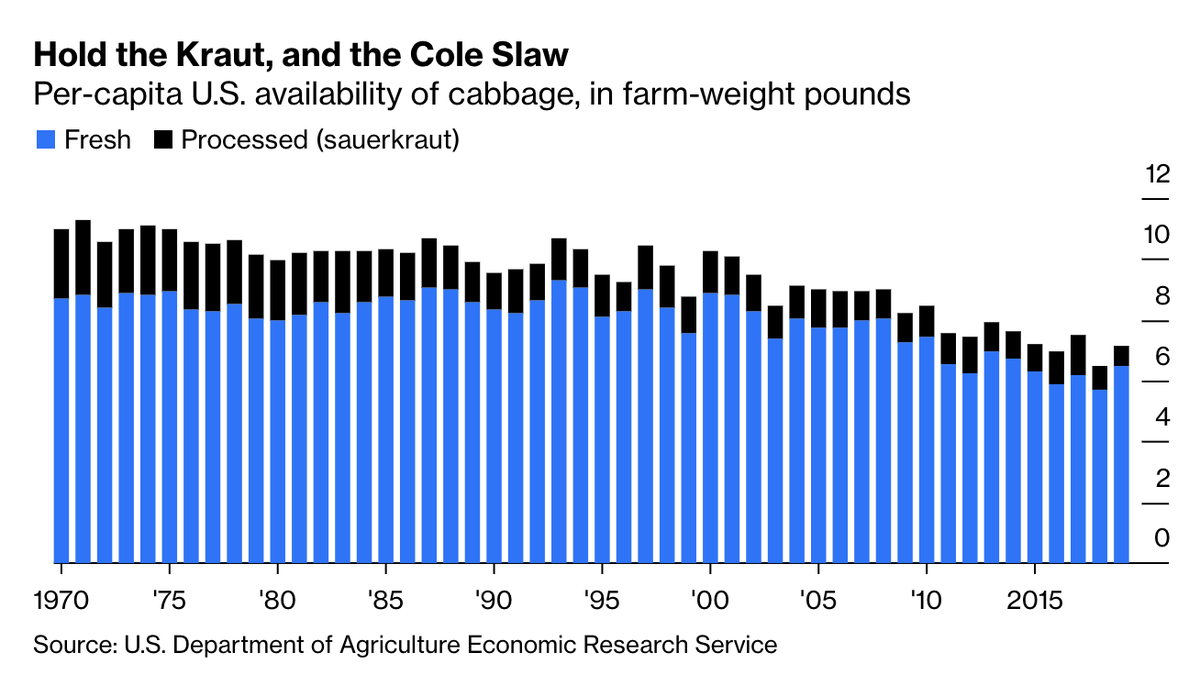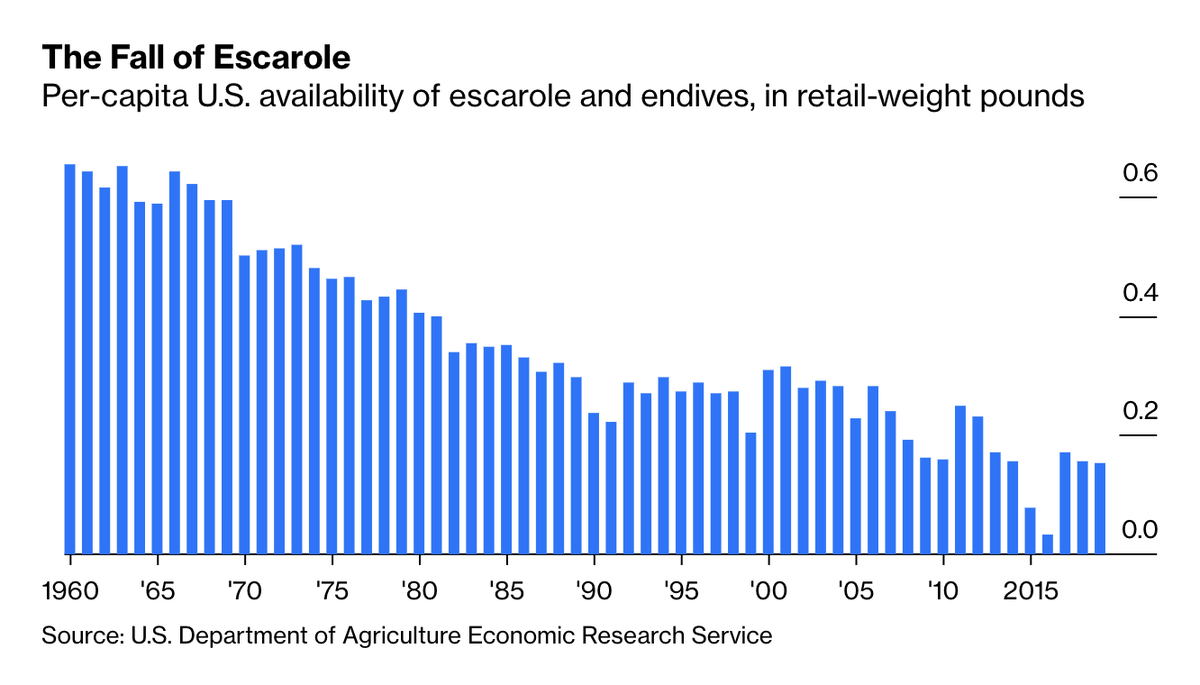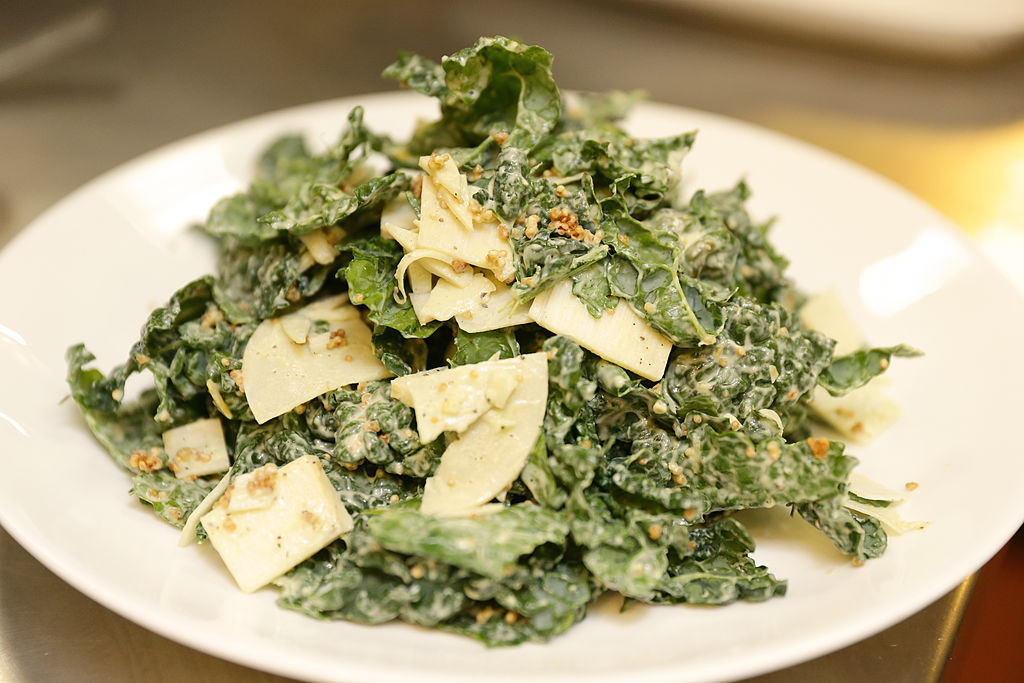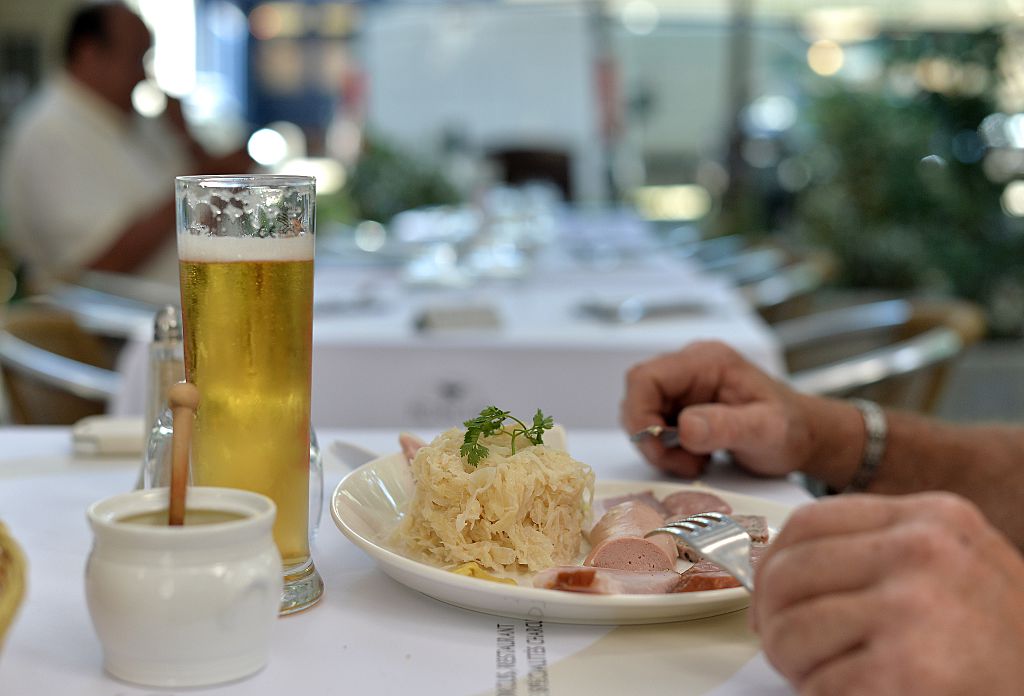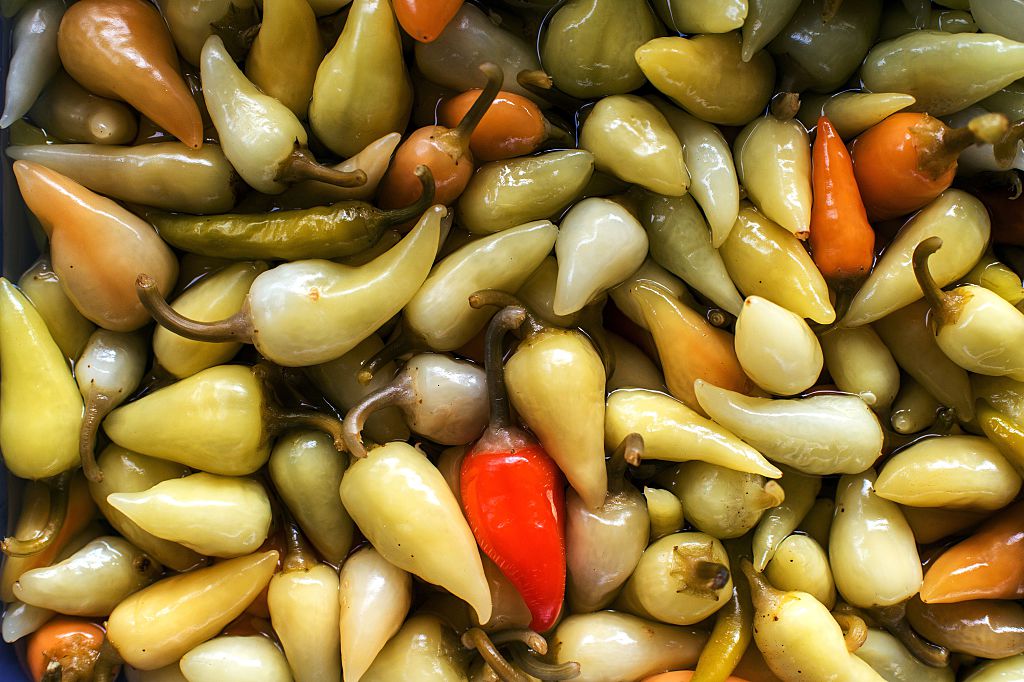It’s possible 2020 will be remembered as a turning point in American history, a moment after which the nation becomes irretrievably different.
That’s right, it could be the year consumption of romaine and other leaf lettuce finally surpasses iceberg https://trib.al/4iwpnC2 ">https://trib.al/4iwpnC2&q...
That’s right, it could be the year consumption of romaine and other leaf lettuce finally surpasses iceberg https://trib.al/4iwpnC2 ">https://trib.al/4iwpnC2&q...
It’s been quite the comedown over the past three decades for America’s iceberg lettuce, introduced by seed purveyor W. Atlee Burpee & Co in 1894.
So how did the so-called “polyester of greens” fall out of favor? https://trib.al/4iwpnC2 ">https://trib.al/4iwpnC2&q...
So how did the so-called “polyester of greens” fall out of favor? https://trib.al/4iwpnC2 ">https://trib.al/4iwpnC2&q...
In 1961, Julia Child + Simone Beck’s “Mastering the Art of French Cooking” & Craig Claiborne’s “The New York Times Cookbook” led to the great American food awakening.
More flavorful greens entered the U.S. diet:
 https://abs.twimg.com/emoji/v2/... draggable="false" alt="🌱" title="Setzling" aria-label="Emoji: Setzling">Arugula
https://abs.twimg.com/emoji/v2/... draggable="false" alt="🌱" title="Setzling" aria-label="Emoji: Setzling">Arugula
 https://abs.twimg.com/emoji/v2/... draggable="false" alt="🥗" title="Grüner Salat" aria-label="Emoji: Grüner Salat">Radicchio
https://abs.twimg.com/emoji/v2/... draggable="false" alt="🥗" title="Grüner Salat" aria-label="Emoji: Grüner Salat">Radicchio
 https://abs.twimg.com/emoji/v2/... draggable="false" alt="🥬" title="Leafy green" aria-label="Emoji: Leafy green">Frisee
https://abs.twimg.com/emoji/v2/... draggable="false" alt="🥬" title="Leafy green" aria-label="Emoji: Leafy green">Frisee
 https://abs.twimg.com/emoji/v2/... draggable="false" alt="🌿" title="Kräuter" aria-label="Emoji: Kräuter">Mesclun http://trib.al/4iwpnC2 ">https://trib.al/4iwpnC2&q...
https://abs.twimg.com/emoji/v2/... draggable="false" alt="🌿" title="Kräuter" aria-label="Emoji: Kräuter">Mesclun http://trib.al/4iwpnC2 ">https://trib.al/4iwpnC2&q...
More flavorful greens entered the U.S. diet:
Head lettuce consumption didn’t peak nationally until 1989.
That’s when, after 20 years of trying, California grower Fresh Express finally figured out how to put pre-cut, pre-washed salad greens in a bag and keep them fresh http://trib.al/4iwpnC2 ">https://trib.al/4iwpnC2&q...
That’s when, after 20 years of trying, California grower Fresh Express finally figured out how to put pre-cut, pre-washed salad greens in a bag and keep them fresh http://trib.al/4iwpnC2 ">https://trib.al/4iwpnC2&q...
Leafy green numbers can tell some interesting stories. Consider kale:
Per-capita availability quadrupled from 2006 to 2017 http://trib.al/4iwpnC2 ">https://trib.al/4iwpnC2&q...
Per-capita availability quadrupled from 2006 to 2017 http://trib.al/4iwpnC2 ">https://trib.al/4iwpnC2&q...
Last year, @amandamull unleashed a brief, intense debate over kale by asserting that, after emerging “as a status symbol for a generation of young adults drawn to conspicuous health-consciousness,” kale is on the way out because it doesn’t taste good http://trib.al/4iwpnC2 ">https://trib.al/4iwpnC2&q...
Sales did stop rising a couple of years ago, but oversupply may be part of the explanation, too. The acres of kale harvested in the U.S. jumped massively:
 https://abs.twimg.com/emoji/v2/... draggable="false" alt="🥬" title="Leafy green" aria-label="Emoji: Leafy green">2012: 6,256
https://abs.twimg.com/emoji/v2/... draggable="false" alt="🥬" title="Leafy green" aria-label="Emoji: Leafy green">2012: 6,256
 https://abs.twimg.com/emoji/v2/... draggable="false" alt="🥬" title="Leafy green" aria-label="Emoji: Leafy green">2017: 15,235 http://trib.al/4iwpnC2 ">https://trib.al/4iwpnC2&q...
https://abs.twimg.com/emoji/v2/... draggable="false" alt="🥬" title="Leafy green" aria-label="Emoji: Leafy green">2017: 15,235 http://trib.al/4iwpnC2 ">https://trib.al/4iwpnC2&q...
It’s possible the nation’s farmers got a bit ahead of the market. Kale is now planted in every state, with even nine acres in Alaska.
Overall, consumption of dark, leafy greens such as kale seems to be on a modest uptrend http://trib.al/4iwpnC2 ">https://trib.al/4iwpnC2&q...
Overall, consumption of dark, leafy greens such as kale seems to be on a modest uptrend http://trib.al/4iwpnC2 ">https://trib.al/4iwpnC2&q...
Spinach has been having a moment for a while, but how it makes its way into our kitchens has changed a lot:
 https://abs.twimg.com/emoji/v2/... draggable="false" alt="🥫" title="Dosen-Fraß" aria-label="Emoji: Dosen-Fraß">In 1960, cans and frozen packages dominated
https://abs.twimg.com/emoji/v2/... draggable="false" alt="🥫" title="Dosen-Fraß" aria-label="Emoji: Dosen-Fraß">In 1960, cans and frozen packages dominated
 https://abs.twimg.com/emoji/v2/... draggable="false" alt="🌱" title="Setzling" aria-label="Emoji: Setzling">Now, 75% is purchased fresh http://trib.al/4iwpnC2 ">https://trib.al/4iwpnC2&q...
https://abs.twimg.com/emoji/v2/... draggable="false" alt="🌱" title="Setzling" aria-label="Emoji: Setzling">Now, 75% is purchased fresh http://trib.al/4iwpnC2 ">https://trib.al/4iwpnC2&q...
Canning has also lost market share among cabbage eaters, for cultural reasons.
While @foxjust has been keeping up his sauerkraut consumption, the rest of us have been slacking. The same goes for coleslaw http://trib.al/4iwpnC2 ">https://trib.al/4iwpnC2&q...
While @foxjust has been keeping up his sauerkraut consumption, the rest of us have been slacking. The same goes for coleslaw http://trib.al/4iwpnC2 ">https://trib.al/4iwpnC2&q...
Escarole has also fallen out of favor. It& #39;s largely associated with Italian food, but it hasn’t gone mainstream like pizza.
It’s not for lack of trying. In 1996, Alice Waters devoted 11 pages to the chicory family in her book “Chez Panisse Vegetables” http://trib.al/4iwpnC2 ">https://trib.al/4iwpnC2&q...
It’s not for lack of trying. In 1996, Alice Waters devoted 11 pages to the chicory family in her book “Chez Panisse Vegetables” http://trib.al/4iwpnC2 ">https://trib.al/4iwpnC2&q...
What this all appears to be is the compounding of two trends.
The first is the pushing aside of long-time American staples such as coleslaw and iceberg lettuce in favor of more sophisticated fare http://trib.al/4iwpnC2 ">https://trib.al/4iwpnC2&q...
The first is the pushing aside of long-time American staples such as coleslaw and iceberg lettuce in favor of more sophisticated fare http://trib.al/4iwpnC2 ">https://trib.al/4iwpnC2&q...
The second trend is the disappearance of certain ethnic food traditions & the emergence of others.
As German-Americans become, well, just American, the taste for sauerkraut has disappeared http://trib.al/4iwpnC2 ">https://trib.al/4iwpnC2&q...
As German-Americans become, well, just American, the taste for sauerkraut has disappeared http://trib.al/4iwpnC2 ">https://trib.al/4iwpnC2&q...
Meanwhile, the availability of processed chili peppers has more than doubled since the early 1980s.
And cabbage isn’t quite out yet; it’s also a key ingredient in the Korean staple kimchi, which saw sales skyrocket in the early days of the pandemic http://trib.al/4iwpnC2 ">https://trib.al/4iwpnC2&q...
And cabbage isn’t quite out yet; it’s also a key ingredient in the Korean staple kimchi, which saw sales skyrocket in the early days of the pandemic http://trib.al/4iwpnC2 ">https://trib.al/4iwpnC2&q...

 Read on Twitter
Read on Twitter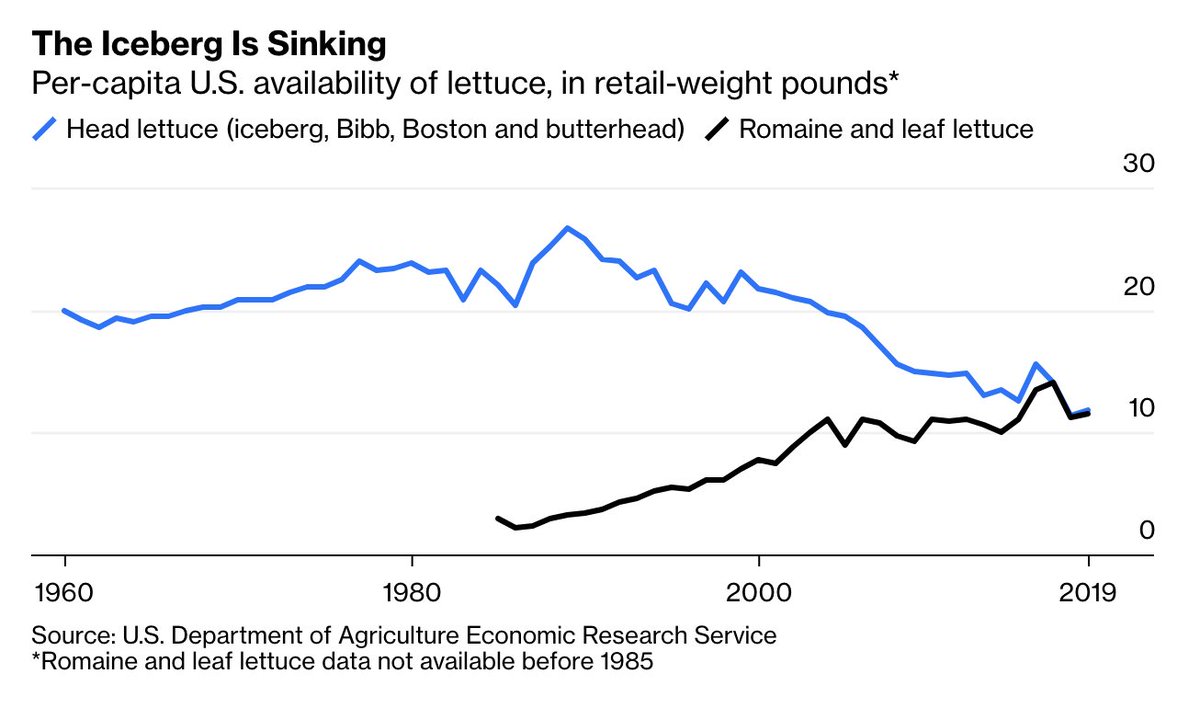
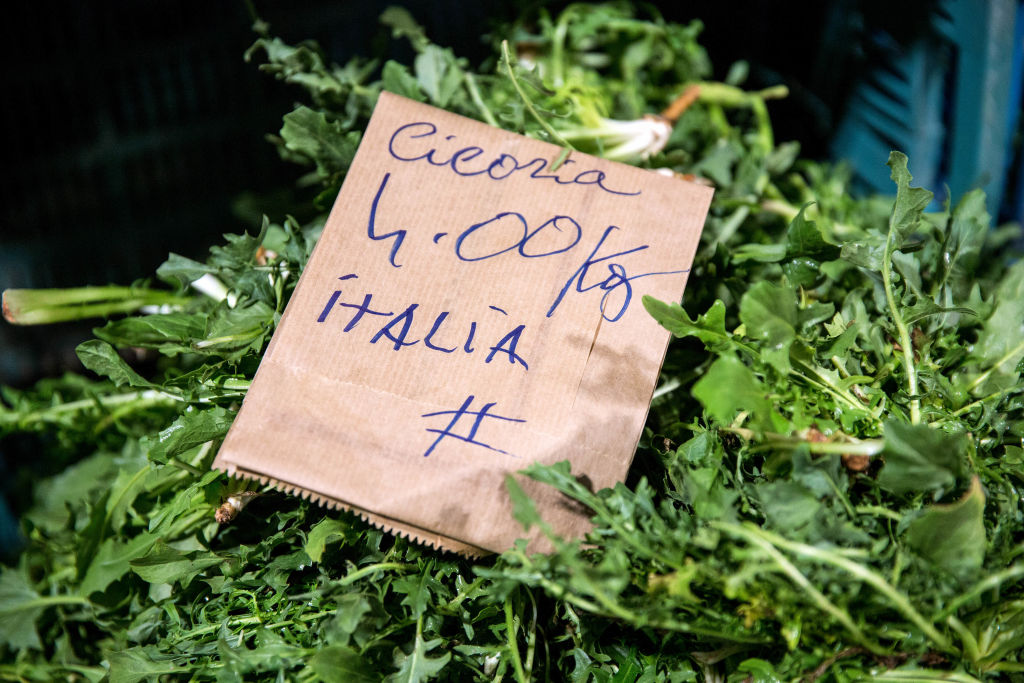 Arugulahttps://abs.twimg.com/emoji/v2/... draggable="false" alt="🥗" title="Grüner Salat" aria-label="Emoji: Grüner Salat">Radicchiohttps://abs.twimg.com/emoji/v2/... draggable="false" alt="🥬" title="Leafy green" aria-label="Emoji: Leafy green">Frisee https://abs.twimg.com/emoji/v2/... draggable="false" alt="🌿" title="Kräuter" aria-label="Emoji: Kräuter">Mesclun https://trib.al/4iwpnC2&q..." title="In 1961, Julia Child + Simone Beck’s “Mastering the Art of French Cooking” & Craig Claiborne’s “The New York Times Cookbook” led to the great American food awakening.More flavorful greens entered the U.S. diet:https://abs.twimg.com/emoji/v2/... draggable="false" alt="🌱" title="Setzling" aria-label="Emoji: Setzling">Arugulahttps://abs.twimg.com/emoji/v2/... draggable="false" alt="🥗" title="Grüner Salat" aria-label="Emoji: Grüner Salat">Radicchiohttps://abs.twimg.com/emoji/v2/... draggable="false" alt="🥬" title="Leafy green" aria-label="Emoji: Leafy green">Frisee https://abs.twimg.com/emoji/v2/... draggable="false" alt="🌿" title="Kräuter" aria-label="Emoji: Kräuter">Mesclun https://trib.al/4iwpnC2&q..." class="img-responsive" style="max-width:100%;"/>
Arugulahttps://abs.twimg.com/emoji/v2/... draggable="false" alt="🥗" title="Grüner Salat" aria-label="Emoji: Grüner Salat">Radicchiohttps://abs.twimg.com/emoji/v2/... draggable="false" alt="🥬" title="Leafy green" aria-label="Emoji: Leafy green">Frisee https://abs.twimg.com/emoji/v2/... draggable="false" alt="🌿" title="Kräuter" aria-label="Emoji: Kräuter">Mesclun https://trib.al/4iwpnC2&q..." title="In 1961, Julia Child + Simone Beck’s “Mastering the Art of French Cooking” & Craig Claiborne’s “The New York Times Cookbook” led to the great American food awakening.More flavorful greens entered the U.S. diet:https://abs.twimg.com/emoji/v2/... draggable="false" alt="🌱" title="Setzling" aria-label="Emoji: Setzling">Arugulahttps://abs.twimg.com/emoji/v2/... draggable="false" alt="🥗" title="Grüner Salat" aria-label="Emoji: Grüner Salat">Radicchiohttps://abs.twimg.com/emoji/v2/... draggable="false" alt="🥬" title="Leafy green" aria-label="Emoji: Leafy green">Frisee https://abs.twimg.com/emoji/v2/... draggable="false" alt="🌿" title="Kräuter" aria-label="Emoji: Kräuter">Mesclun https://trib.al/4iwpnC2&q..." class="img-responsive" style="max-width:100%;"/>
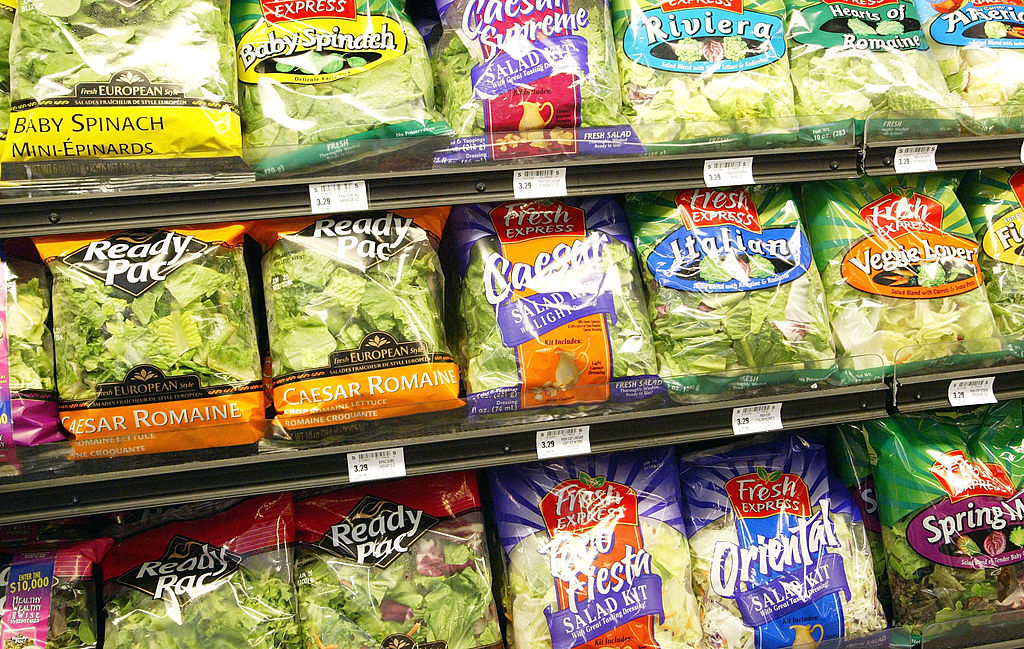
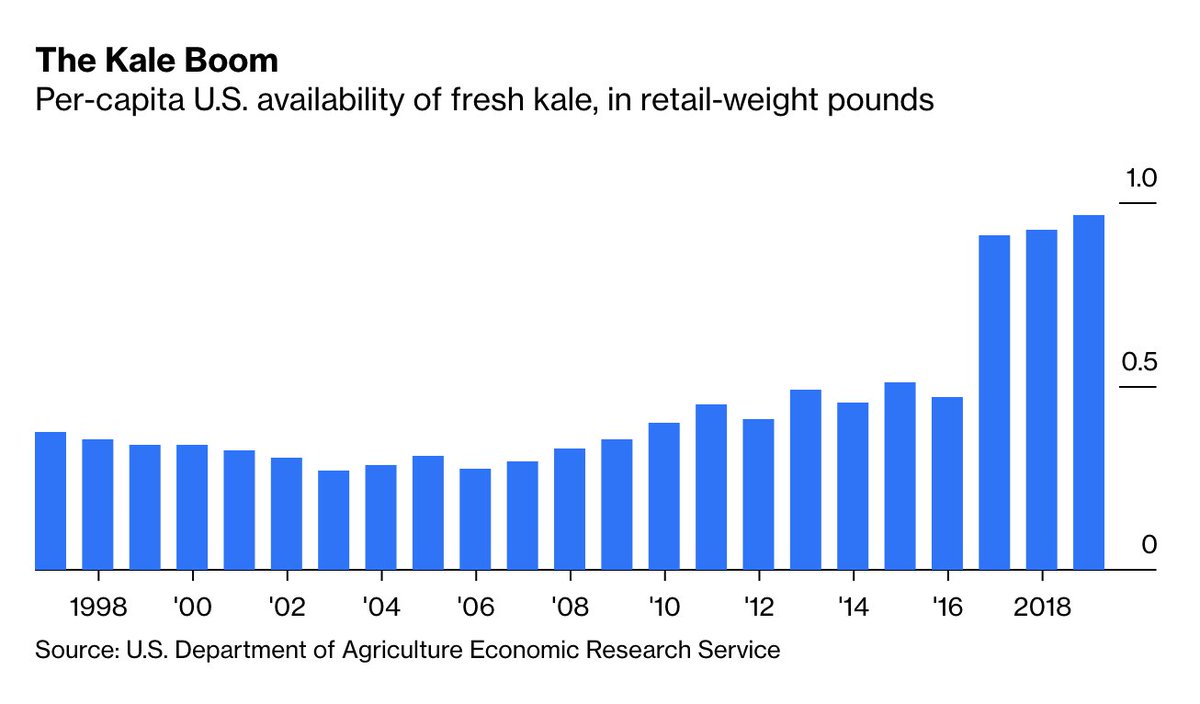
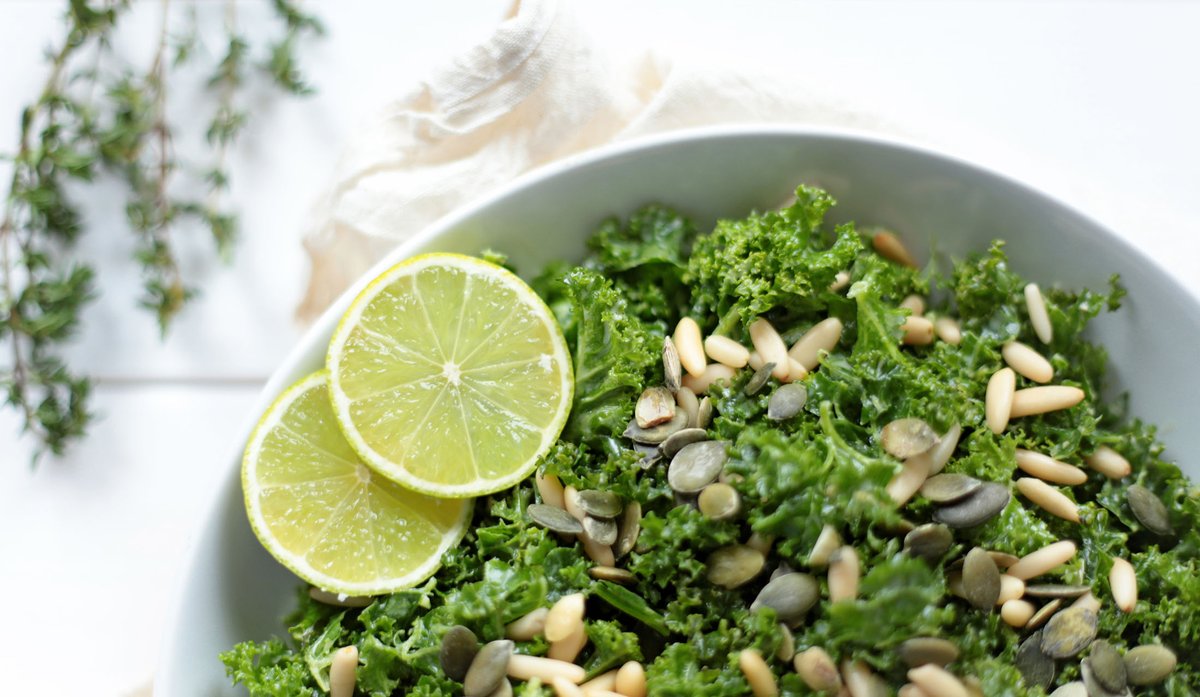
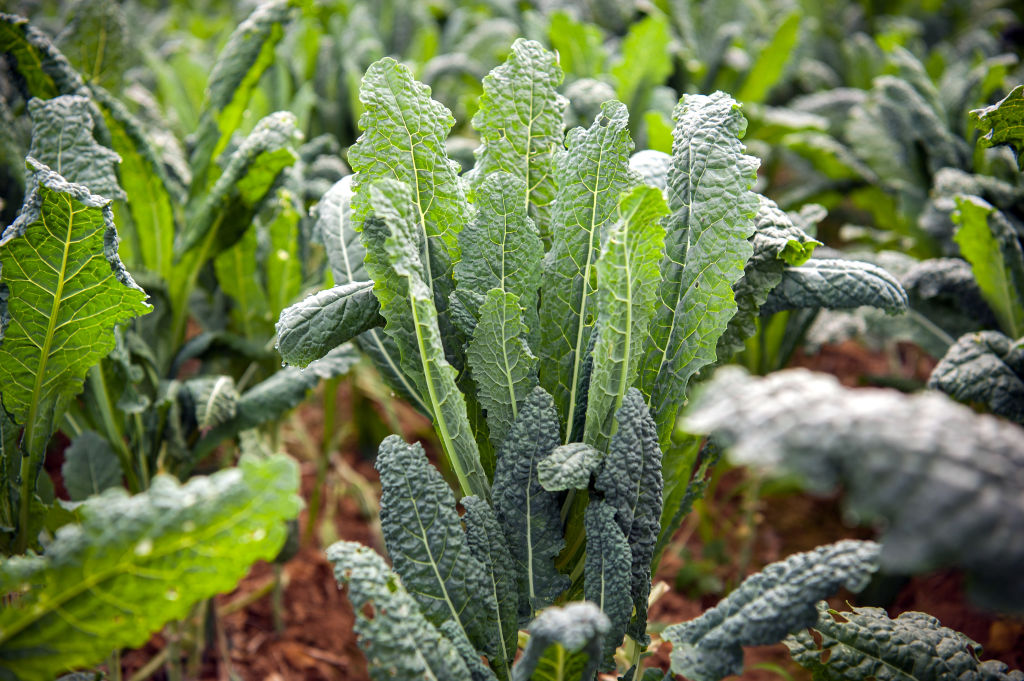 2012: 6,256https://abs.twimg.com/emoji/v2/... draggable="false" alt="🥬" title="Leafy green" aria-label="Emoji: Leafy green">2017: 15,235 https://trib.al/4iwpnC2&q..." title="Sales did stop rising a couple of years ago, but oversupply may be part of the explanation, too. The acres of kale harvested in the U.S. jumped massively:https://abs.twimg.com/emoji/v2/... draggable="false" alt="🥬" title="Leafy green" aria-label="Emoji: Leafy green">2012: 6,256https://abs.twimg.com/emoji/v2/... draggable="false" alt="🥬" title="Leafy green" aria-label="Emoji: Leafy green">2017: 15,235 https://trib.al/4iwpnC2&q..." class="img-responsive" style="max-width:100%;"/>
2012: 6,256https://abs.twimg.com/emoji/v2/... draggable="false" alt="🥬" title="Leafy green" aria-label="Emoji: Leafy green">2017: 15,235 https://trib.al/4iwpnC2&q..." title="Sales did stop rising a couple of years ago, but oversupply may be part of the explanation, too. The acres of kale harvested in the U.S. jumped massively:https://abs.twimg.com/emoji/v2/... draggable="false" alt="🥬" title="Leafy green" aria-label="Emoji: Leafy green">2012: 6,256https://abs.twimg.com/emoji/v2/... draggable="false" alt="🥬" title="Leafy green" aria-label="Emoji: Leafy green">2017: 15,235 https://trib.al/4iwpnC2&q..." class="img-responsive" style="max-width:100%;"/>
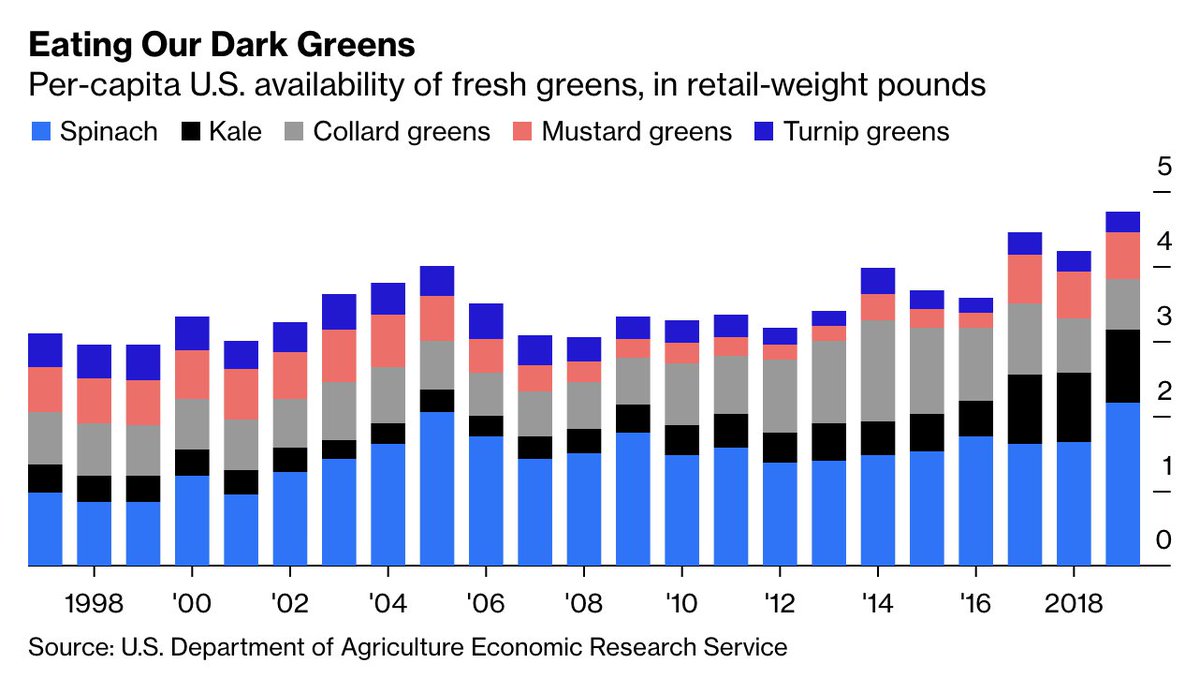
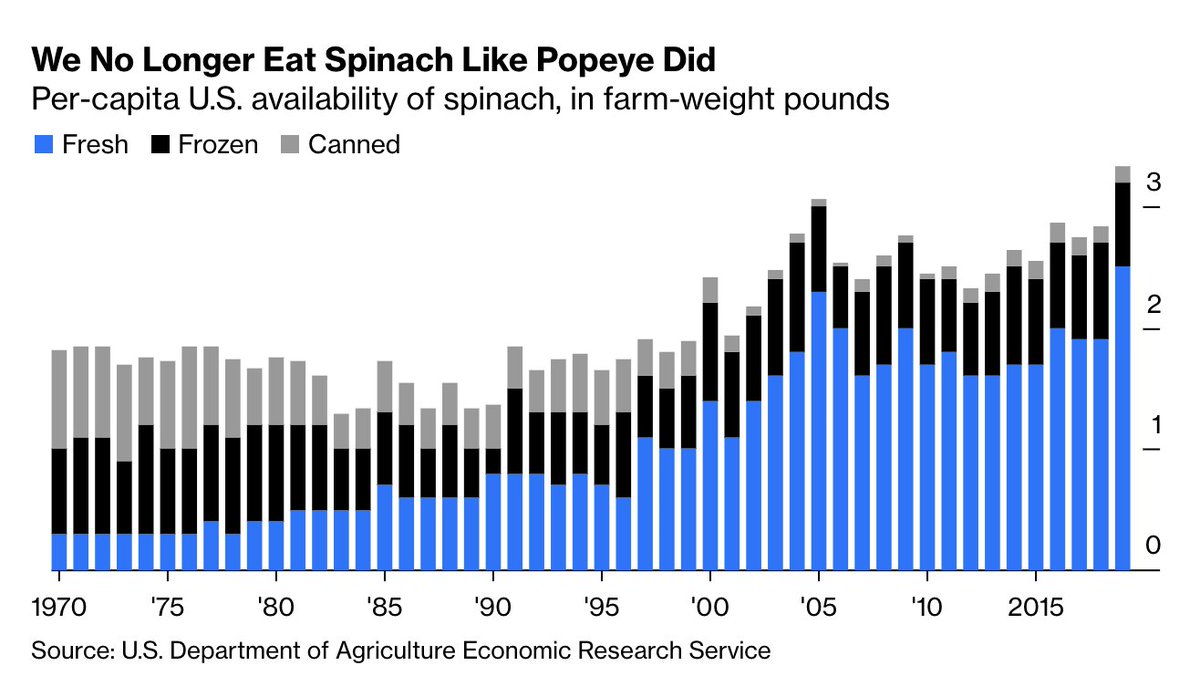 In 1960, cans and frozen packages dominatedhttps://abs.twimg.com/emoji/v2/... draggable="false" alt="🌱" title="Setzling" aria-label="Emoji: Setzling">Now, 75% is purchased fresh https://trib.al/4iwpnC2&q..." title="Spinach has been having a moment for a while, but how it makes its way into our kitchens has changed a lot:https://abs.twimg.com/emoji/v2/... draggable="false" alt="🥫" title="Dosen-Fraß" aria-label="Emoji: Dosen-Fraß">In 1960, cans and frozen packages dominatedhttps://abs.twimg.com/emoji/v2/... draggable="false" alt="🌱" title="Setzling" aria-label="Emoji: Setzling">Now, 75% is purchased fresh https://trib.al/4iwpnC2&q..." class="img-responsive" style="max-width:100%;"/>
In 1960, cans and frozen packages dominatedhttps://abs.twimg.com/emoji/v2/... draggable="false" alt="🌱" title="Setzling" aria-label="Emoji: Setzling">Now, 75% is purchased fresh https://trib.al/4iwpnC2&q..." title="Spinach has been having a moment for a while, but how it makes its way into our kitchens has changed a lot:https://abs.twimg.com/emoji/v2/... draggable="false" alt="🥫" title="Dosen-Fraß" aria-label="Emoji: Dosen-Fraß">In 1960, cans and frozen packages dominatedhttps://abs.twimg.com/emoji/v2/... draggable="false" alt="🌱" title="Setzling" aria-label="Emoji: Setzling">Now, 75% is purchased fresh https://trib.al/4iwpnC2&q..." class="img-responsive" style="max-width:100%;"/>
